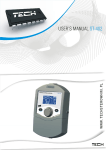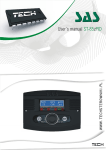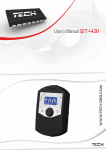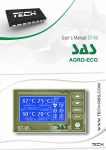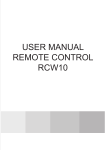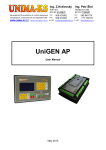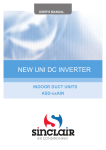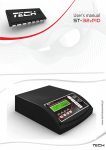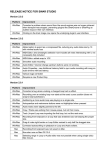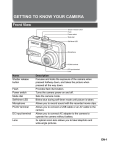Download IV.j) Room Regulator Temperature
Transcript
tech -1- ST – 430 user's manual Declaration of Conformity No. 33/2010 Hereby, we declare under sole responsibility that the ST-430 230V, 50Hz thermoregulator manufactured by TECH, ul. St. Batorego 14, 34-120 Andrychów, is compliant with the Regulation by the Ministry of Economy (Journal of Laws Dz.U.03.49.414) of 12 March 2003 implementing provisions of the Low Voltage Directive (LVD) 2006/95/EC, and the Regulation by the Ministry of Infrastructure (Journal of Laws Dz.U.03.90.848) of 2 April 2003 implementing provisions of the Directive 2004/108/EC. The ST-430 controller has been tested for electromagnetic compatibility (EMC) with optimal loads applied. For compliance assessment, harmonized standards were used: PN-EN 60730-2-1:2002. Paweł Jura, Janusz Master -2- tech ATTENTION! HIGH VOLTAGE! Make sure the regulator is disconnected from the mains before working on the power supply (cable connections, device installation, etc.)! All connection works must only be carried out by qualified electricians. Before activating the controller, measure the motor resetting efficiency and inspect wire insulation. -3- ST – 430 user's manual -4- tech I. Intended Use The ST-430 thermoregulator is intended to operate a three- or fourway mixing valve with an option of connecting an additional valve pump. The controller features a floor heating control function and can be connected to a room temperature regulator. The additional functionality of return temperature protection serves to prevent water from boiling in the short boiler circuit and from becoming too cold when returning to the boiler. II. Principle of Operation Description of the control panel SETPOINT TEMPERATURE % OF OPENING TEMPERATURE DOWNSTREAM OF VALVE DEVICE STATUS DEVICE ACTIVATED STANDBY MODE EXIT ENCODER By principle, the valve is intended to mix hot circulation water supplied with water that returns from the heating circuit in order to -5- ST – 430 user's manual obtain and maintain the desired temperature. In circuits other than based on gravity circulation, water is distributed with pumps connected to each valve. The pump should be mounted downstream of the mixing valve, whereas the temperature sensor should be mounted downstream of both the valve and the pump, so as to be able to precisely monitor the temperature at the valve outlet. CAUTION: if the controller of the valve is operating simultaneously in a common circulation with the controller of the boiler, the pump has to be connected with the controller of the boiler (pump exit of ST-430 controller will remain unused). The device is controlled with an encoder knob. By pressing the knob, you can enter a menu or confirm settings. By turning the knob, you can navigate in menu functions. To go to a higher menu level, use the Exit button. All settings are changed in the same manner. II.a) Main Page During normal operation, the graphic display shows the Main Page containing the following: - temperature downstream of the valve; - setpoint temperature; - valve opening in %; - device status. By turning the encoder, you can easily change the setpoint temperature. Press the encoder knob to go to the Main Menu. You can switch the Main Page to display the temperature at the sensors by pressing and holding for several seconds the EXIT button. Then, when the Sensor Temperature function is enabled, the Main Page will display valve, return and outdoor temperatures. To the right of the display, a Device Status icon is located which, -6- tech depending on the symbol, provides the following information on the device: the valve is disabled with the menu; the valve is enabled with the menu; (flashing) the valve is enabled but the controller is currently in the return protection mode; the controller is calibrating the valve – during this period, the pump is stopped to disable water circulation as its temperature is not monitored during calibration; the controller is in the room temperature regulation mode; (flashing) the controller is in the room temperature regulation mode, although the room temperature is insufficient; the controller is in the weather regulation mode. II.b) Indication LEDs To the right of the display, three indication LEDs are located, showing the status of the actuators. The first LED is used to indicate the manual mode and it is on when the mode is active. If it flashes, the valve calibration has not been finished yet. In such case, wait for the LED to stop flashing or, alternatively, close the valve, thus desynchronizing it. The second LED is used to indicate activation of the pump. The LED stays lit when the pump is running. The LED starts flashing when the valve enters the calibration mode and the pump is enabled with the menu. During the calibration, the pump is stopped so that there is no temperature change in the system. The pump is restarted when the calibration process is finished. -7- ST – 430 user's manual The third LED is used to indicate activation of the valve (run). III. Main Menu III.a) Setpoint Temperature With this option, you can set the setpoint temperature that is to be maintained by the valve. Typically, the valve sensor temperature is intended to approach the setpoint temperature defined for the valve. III.b) Enabled With this option, you can enable the mixing valve. If the option is disabled, the adjacent box is empty. Disabling the valve will stop the pump. Even with the valve being disabled, energizing the controller is followed by calibration. This is to prevent the valve from being left in a position that is unsafe for the circuit. III.c) Valve Calibration With this function, you can set the initial position of the valve. During calibration, the valve is set to its safe position, i.e. fully opened in case of the central heating valve, and closed in case of the floor heating valve. III.d) Screen selection This function allows the user to switch the screen appearance (main page appearance) between two options – valve view and temperature of sensors view. If the temperature of sensors view is chosen the display will show the temperature of the valve, the return and the external temperature. If the valve view is chosen the main page will present current and set temperatures of the valve and the percentage of valve gap (abatement). -8- tech III.e) Manual Mode When the Manual Mode option is selected, you can manually control the percentage of valve opening as well as start or stop the pump. III.f) Language choice The user can choose the language version of the controller. III.g) Factory Settings The regulator has been pre-configured. However, it should be adjusted to your individual needs. It is possible to return to the factory settings at any time. By enabling factory settings, all user-defined settings will be replaced by settings made by the manufacturer. From then on, you can again set your own operating parameters. IV. Fitter’s Menu IV.a) Pump Enabled With this parameter, you specify whether the pump is to run when the valve is in operation. IV.b) Return Protection The function serves to protect water from boiling in the short boiler circuit and from becoming too cool when returning from the main circuit and so causing low-temperature corrosion in the boiler. When the temperature in the short boiler circuit is too high, the return protection opens the valve and starts to distribute water in the circuit in order to maintain a safe temperature and protect the boiler from possible damage. The return temperature protection is disabled when the valve is set to the floor heating mode as it could damage fragile floor pipes. If the -9- ST – 430 user's manual temperature is too low, the valve is closed until the appropriate temperature is reached in the short boiler circuit. Protection parameters are adjusted in the RETURN PROTECTION SETTINGS menu. IV.c) Return Protection Settings In this submenu, the following return protection parameters are set: MINIMUM TEMP - minimum temperature in the short boiler circuit to be maintained before the valve is opened. MAXIMUM TEMP - maximum temperature permitted in the short boiler circuit. STOP PUMP - with this option enabled, the pump is stopped when the return sensor temperature is lower than the minimum temperature and the valve is closed. This option can be of use if you do not want the pump to run when the boiler is damped. IV.d) Valve Type With this function, you can specify the type of your controlled valve from among the following: C.H. – to be set when the central heating temperature is to be regulated. FLOOR – to be set when the floor heating temperature is to be regulated. The floor type is intended to protect the floor heating system from dangerous temperatures. Fragile as it is, the floor system may be damaged if the valve type is specified as C.H. and the valve is connected to the floor heating system. IV.e) Operation Mode With this function, you can select an operation mode from among the following: STANDARD – the controller maintains the setpoint temperature of the - 10 - tech valve outlet. ROOM REGULATION – the controller maintains the setpoint temperature of the valve until the room regulator sends a signal to reheat the room. Then, the ROOM REGULATOR TEMPERATURE becomes the setpoint temperature (fitter’s menu). The lower temperature is not displayed on the main screen; however, the valve ignores the main setpoint temperature and maintains the reheating temperature of the room regulator. The room reheating signal from the room regulator is indicated by the room regulator symbol. WEATHER CONTROL – the setpoint temperature of the valve depends on the outdoor temperature. It is calculated based on parameters saved in the WEATHER CHARACTERISTIC field. ROOM AND WEATHER CONTROL – In this mode, if the room controller does not reach the set temperature the valve is operating exactly in the same manner as in weather control mode (in accordance with WEATHER CHAR. parameter). When the room temperature reaches the set value the valve will switch to operation in accordance with room control mode (with room temperature on the set level). While this mode is active the symbols of weather control and room control are pulsating on the display. After the set temperature has been reached the symbol of room control (with room temperature on the set level) is shown on the display. IV.f) Summer Mode In this mode, the regulator closes the central heating valve to prevent the house from being heated when it is not required. In case the boiler temperature is too high (return protection needs to be enabled), the valve is opened. The mode is disabled for the floor heating valve control. - 11 - ST – 430 user's manual IV.g) Opening Time This parameter is used to define time required by the valve actuator to open the valve from 0% to 100%. This time is to be set depending on the valve actuator used (specified on the name plate). IV.h) Measurement Pause This parameter determines the sampling (checking) frequency for water temperature downstream of the valve, i.e. the sensitivity of the valve. If a temperature change (deviation from the setpoint value) is detected, the solenoid valve will be opened or closed by a defined amount, so that the setpoint temperature is reached. The higher the parameter, the higher the inertia of the temperature. IV.i) Maximum Stroke This parameter defines the maximum value of a single valve stroke (for opening or closing) during temperature sampling. If the temperature is close to the setpoint value, the stroke is calculated based on the PROPORTIONALITY COEFFICIENT parameter. The smaller the single stroke, the higher the precision of obtaining the setpoint temperature, although the setpoint value is maintained longer. IV.j) Room Regulator Temperature With this function, you can determine the temperature to be maintained by the valve if the OPERATION MODE is set to ROOM REGULATION and the room regulator requests reheating. IV.k) Proportionality Coefficient The proportionality coefficient is used to define the stroke of the valve. The closer is the temperature to the setpoint value, the smaller is the stroke. When the coefficient is high, the valve opens to a position close to the required one quickly, but with lesser precision. The percent - 12 - tech of opening in a single cycle is calculated based on the following formula: (SETPOINT TEMP. - SENSOR TEMP.) * (PROPORTIONALITY COEFF. / 10) IV.l) Minimum Opening With this parameter, it is possible to specify the minimum opening for the valve. It allows you to set an opening small enough to maintain the weakest flow. IV.m) Opening Direction If it turns out that the valve has been connected to the controller reversely, it is not necessary to reconnect it. Instead, you may use this parameter to change the opening direction. LEFT * RIGHT * IV.n) Pumps Anti-stop When this option is activated the pump of the valve will activate every 10 days for 2 minutes. This prevents the water to stand still in the installation out of the heating period. IV.o) Maximum Floor Heating Temperature This is the maximum temperature that will not damage the floor system. This temperature setting is used when the valve is set to the floor heating mode. Once the maximum temperature is reached, the valve is closed and an alarm is sounded to notify the user. IV.p) Weather Characteristic With this parameter, you can set the setpoint temperature for the valve for different outdoor temperature conditions. Such fixed values are used to calculate values for intermediate points. TEMP. FOR -20 TEMP. FOR 0 TEMP. FOR 20 - 13 - ST – 430 user's manual Heating curve – is a curve according to which the controller's setpoint temperature is defined based on the external temperature. In our controllers, the heating curve is constructed based on three values of setpoint temperatures for given external temperatures. The setpoint temperatures must be determined for external temperatures of -20ºC, 0ºC and 20ºC. The more points are used to construct the curve, the better accuracy and flexibility of shaping the curve. In this case, three values seem to be a good compromise between accuracy and simplicity of determining the course of the curve. Where in our controller: XA = -20ºC, XB = 0ºC, XC = 20ºC, YA, YB, YC – setpoint temperatures for external temperatures XA, XB, XC, O1 – increasing the setpoint temperature Increasing/decreasing the setpoint temperature consists in increasing/decreasing the current setpoint temperature as seen on the main page. Such change is automatically followed by an offset of the heating curve by the value being changed. The offset consists in parameters YA, YB, YC being added with the temperature change O1. - 14 - Below shown temperature: are formulae for calculating the tech setpoint current Y B−Y A ⋅ X − X A X B− X A Y −Y B if X ≥ X B ⇒Y =Y B C ⋅ X − X B X C− X B if X X B ⇒ Y =Y A Where: X – current external temperature, Y – calculated setpoint temperature. The third LED indicates that the valve is in operation (moving). V. Standby Mode When the Standby Mode button is pressed on the control panel, all actuators within the system are disabled. The button is used when all actuators need to be immediately disabled. VI. Protections In order to ensure a safe and faultless operation, the regulator has been provided with numerous protections. In the case of an alarm, an acoustic warning is sounded and the display shows an appropriate message. Press the encoder to restore the controller to operation. When an alarm is active, the manual mode is available, although you should make sure your operations will not cause damage. The controller features the following alarm protections: 1. Temperature alarm to disable the temperature control in the valve and set the valve to its safe position, i.e. the floor valve is closed and the central heating valve is open. 2. VALVE SENSOR alarm to indicate that the valve sensor is misconnected, disconnected or faulty. The sensor is key to the proper - 15 - ST – 430 user's manual operation of the valve. Therefore, if faulty, it should be changed as soon as possible. 3. RETURN SENSOR alarm to warn the user when the return protection function is enabled and the return sensor is faulty. The return sensor must then be repaired or changed. The alarm can be disabled by disabling the return protection function. However, this may lead to a serious damage of the boiler or the system if the boiler has no anti-boil protection. 4. WEATHER SENSOR alarm to warn the user that the outdoor temperature sensor is faulty. The alarm can be cancelled if an undamaged sensor is properly fitted. The alarm is not triggered for any operating mode other than the weather control mode. The regulator has a network protection WT 1.6A tube fuse. ATTENTION: it is not advisable to use fuses with higher current ratings. Higher current ratings may cause damage to the controller. V. Maintenance Before and during the heating season, the ST-430 controller should be checked for condition of its cables. You should also check if the controller is properly mounted and clean it if dusty or dirty. Technical Data Temperature adjustment range 8oC : 90oC Supply voltage 230V/50Hz +/- 10% Power consumption Max. 2W Sensor temperature resistance -25oC : 100oC Ambient temperature 10oC : 50oC Load on each output 0.5A Fuse insert 1.6A - 16 - tech VI. Assembly ATTENTION: all assembly works must only be carried out by qualified persons. During assembly, the device must be disconnected (make sure the power cord is unplugged)! Wire connections Installation Diagram - 17 - ST – 430 user's manual Table of Contents I. Intended Use..........................................................................5 II. Principle of Operation..............................................................5 II. a) Main Page.......................................................................6 II. b) Indication LEDs...............................................................7 III. Main Menu.................................................................... 8 III. a) Setpoint Temperature.....................................................8 III. b) Enabled.........................................................................8 III. c) Valve Calibration.............................................................8 III. d) Screen selection.............................................................9 III. e) Manual Mode..................................................................9 III. f) Language choice..............................................................9 III. g) Factory Settings.............................................................9 IV. Fitter’s Menu............................................................... 9 IV. a) Pump Enabled.................................................................9 IV. b) Return Protection............................................................9 IV. c) Return Protection Settings..............................................10 IV. d) Valve Type...................................................................10 IV. e) Operating Mode.............................................................10 IV. f) Summer Mode...............................................................11 IV. g) Opening Time...............................................................12 IV. h) Measurement Pause.......................................................12 IV. i) Maximum Stroke............................................................12 IV. j) Room Regulator Temperature..........................................12 IV. k) Proportionality Coefficient...............................................12 IV. l) Minimum Opening..........................................................13 IV. m) Opening Direction.........................................................13 IV. n) Pump Anti-stop.............................................................13 IV. o) Maximum floor heating temperature................................13 IV. p) Weather Characteristic...................................................13 - 18 - tech V. Standby Mode.................................................................... 14 VI. Protections.................................................................. 14 VII. Maintenance................................................................... 15 VIII. Assembly.......................................................................... 15 We are committed to protecting the environment. Manufacturing electronic devices imposes an obligation of providing for environmentally safe disposal of used electronic components and devices. Hence, we have been entered into a register kept by the Inspection For Environmental Protection. The crossed-out bin symbol on a product means that the product may not be disposed of to household waste containers. Recycling of wastes helps to protect the environment. The user is obliged to transfer their used equipment to a collection point where all electric and electronic components will be recycled. - 19 - ST – 430 user's manual - 20 -




















